

|
August, 2021 Update from Family Garden TrainsTM
Note: This is the web version of a newsletter from the Family Garden TrainsTM web site, which publishes information about running big model trains in your garden as a family activity.
If you are not subscribed to the Family Garden Trains newsletter, and you would like to subscribe, please join our Mailing List, and specify that you want to receive e-mail updates.
Also, if you would like to subscribe to our free newsletter for indoor railroads and seasonal display villages, please join the "Trains-N-TownsTM mailing list. You can subscribe to either, both, or neither, and we will just be glad to be of service, no matter what you decide.
Fine Print: If you are receiving our e-mail updates and you no longer wish to subscribe, please e-mail me with a "Please Unsubscribe" message (worded any way you wish), and we will graciously remove you from our list.
Update for August, 2021
Our trip to attend the National Garden Railway Convention in Nashville was only one of several we made this spring. So we got in a lot of travel and family time, and then I got started on more upgrades to my railroad.
Tasks I've been working on include framing two short tunnels to add interest to two small loops I added this spring. I framed in "boxes," then dirtscaped over them. Then I dirtscaped around them so it didn't necessarily look like mountains were springing up out of nowhere. Finally, I set out most of my model buildings for a train club visit in early August.
Though the railroad is starting to look more like we've envisioned it, we still hope to be a little farther along by an open railroad in October, as well as a Christmas-themed open railroad in November, part of an annual tradition on our railroad. Stay tuned. During the convention, I also learned more about fellow writer and hobbyist Nancy Norris' garden railway consultation business, so I've provided a link here. If nothing else check out the "Projects" gallery on her site for some inspiration.
Looking for some building accessories, I found a new source for buildings, including several that will be especially interesting to folks who model English railways. If only I didn't have so many other projects in the queue.
Hoping this season is treating you well, and that you're getting to spend time with your loved ones.
Whatever your modeling, railroading, or gardening interests, stay tuned. Every newsletter, we try to publish more, updated, helpful information.
In the meantime, have a great summer!
In This Issue
The following content is linked to or included in this newsletter:
- Tunnel Framing on the NEW New Boston and Donnels Creek, Part 1 - First steps in adding short tunnels to two small tracks on the new platforms.
- Tunnel Framing on the NEW New Boston and Donnels Creek, Part 2 - Layering rocks, dirt, plants, and shrubs to create "mountains" over the new tunnel frames.
- Dirtscaping on the NEW New Boston and Donnels Creek, Part 3 - We've been using the term "dirtscaping" to describe out efforts to use natural materials like rocks, dirt, shrubs, and groundcovers to help our raised platform railroad look more natural. This article describes the efforts we took to surround our new "mountains" with other topography to help them look more like they belonged there.
- Garden Lines - Nancy Norris' Garden Railroad Design and Construction Services - Nancy Norris, whom we know chiefly from her plant articles and clinics, has a business designing and building garden railroads, most of which seem to feature great - you guessed it - choice of plants.
- Kippo Models - UK-Inspired Resin Kits - Yet another source for Large Scale buildings, especially if you have a taste for Irish and UK railroading.
- Family Garden Trains You-Tube Channel - The beginning of an effort to corral the little videos that are currently scattered around the Internet.
- Garden Railroading in Early Autumn
After installing track and roadbed on our railroad's new platforms, they still looked very naked, because they need rocks, dirt, and plants. But before I did that, I wanted to add short tunnels to two of the little loops that will serve our future communities with streetcars and the like.
If I had planned these from the beginning, it would have been easier. As it was, I had to fiddle with various measurements and approaches to get tunnels that would provide the right amount of clearance, both horizontally and vertically. Once the framework for the tunnels was complete, my plan was to cover the framework with vinyl and camouflage it with rocks, dirt, and plants, hopefully including little trees.
Click here to see how that project was progressing in mid-July.
After installing track and roadbed on our railroad's new platforms, they still looked very naked, because they need rocks, dirt, and plants. But before I did that, I wanted to add short tunnels to two of the little loops that will serve our future communities with streetcars and the like.
If I had planned these from the beginning, it would have been easier. As it was, I had to fiddle with various measurements and approaches to get tunnels that would provide the right amount of clearance, both horizontally and vertically. Once the framework for the tunnels was complete, my plan was to cover the framework with vinyl and camouflage it with rocks, dirt, and plants, hopefully including little trees.
Click here to see how that project was progressing in late July.
After we finished the basic construction on two short tunnels, we built up rocks, dirt, trees, and groundcovers nearby to help the topography look more natural.
Once the heavy work was done, we also brought a number of our buildings out of storage and set up two small "communities."
Click on the picture to see our status as of early August, 2021.
Nancy Norris, a garden railroader and the most recent (former) plant editor for Garden Railways, also designs and builds beautiful garden railroads for other folks. She has been living in the greater San Francisco area, but just moved to Maine.
If all goes according to plan, she will spend summers in New England and winters in California, so folks on both coasts will have a chance to benefit from her help and advice.
Nancy's business site includes photos of railroads she had built and detailed spreadsheets showing plants that she has found useful in Zones 3 and 4 (some of them are useful to me here in zone 5.5 as well, so the lists are worth perusing).
Her gallery of "projects" includes some very inspiring photos. Resources like this always encourage me to "up my game."
To jump to her home page and check out railroads she has designed and/or built, click here.
Kippo Models, a family business in Scotland is making resin 1:22.5 building models. Because they're resin (and not injection-molded plastic), they take a bit of sanding to fit exactly, but they seem like they'd be very sturdy. As a fellow who always paints his models before setting them out and who has used resin buildings before, that's not a big problem to me. Admittedly, most of their offerings are UK-inspired, but if you're modeling English, Welsh, Scottish, or Irish countryside, these will give you a great start.
The switch tower shown is actually designed after a English prototype (LMS RR), but would fit on any US RR as well. The track next to their buildings is #3 gauge (2.5") in case you wondered why the buildings looks small next to it.
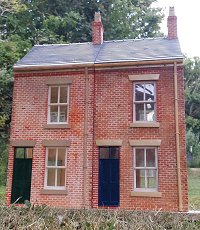 Their "terrace houses" represent what we call "row houses," and represent a very common city residential street infrastructure in the UK and Ireland. They could even be used to represent 12 Grimmauld place, if that is your wont. Their "terrace houses" represent what we call "row houses," and represent a very common city residential street infrastructure in the UK and Ireland. They could even be used to represent 12 Grimmauld place, if that is your wont.
Several small trackside buildings (not shown) are also included, as is a station that would stand in for many of the stations in the small towns of UK and Ireland.
Company owner Edward Williams says there are no US vendors yet - I'm trying to talk a local fellow into looking into it. "Eddy" has listed a few buildings like the ones shown on eBay. The price is actually reasonable, but the shipping from Scotland is outrageous. Not Eddy's fault. Maybe if you wanted to order a bunch at a time, the shippers would give you a break. (That's not up to Eddy, either, so don't jump on him.)
I'll post follow-ups as I learn more about this ambitious "cottage industry." Gee, maybe this warrants a trip to Scotland, once things settle down. ??
In the meantime, if you want to check out the Kippo site for yourself, click here.
I don't make a lot of garden railroading videos, and the ones that I have made are scattered in dumb places around the Internet, which makes them hard to find, even for me.
I have other videos I haven't posted yet, plus I hope to be making some more videos this fall, and I wanted to make them easier to find.
So I scratched together a new YouTube channel just for garden train stuff, and uploaded a handful of videos I've already posted elsewhere.
If you subscribe to the YouTube channel, you should get a "heads-up" whenever new content is posted (though I wouldn't worry about being inundated with content just yet).
Click on the following link to visit the channel:
Garden Railroading in Early Autumn
In so-called temperate zones, September is often the best time of year to operate a garden railroad. Weed growth slows, algae growth in the pond slows, temperatures become reasonable, and generally the weather is a little more predictable. That said, it's also time to start preparing for cooler weather.
Deadheading and Weeding - By the end of September, it's safe to cut off or deadhead most perennial flowers. Some plants like Yarrow, will actually look better in the late fall if you cut them back to within a few inches of the ground by September first - they'll start growing back and filling in.
Weeding-wise, don't let crabgrass, nutgrass, or goldenrod go to seed, or you'll be extra sorry next year. If your railroad experiences an invasion of grasses, you may be able to use "Grass Killer" spray, but try a little at time to make certain you're not going to hurt any plants you want to keep. This is hardly ever a problem, really, but I'm paranoid around plants with grass-like leaves like Grape Hyacinth and Sea Pinks.
Autumn Open Railroads -
Many garden railroaders in the so-called temperate zones have Open Railroads in September. Check with regional clubs to see if they have any scheduled. Visiting other people's railroads will give you many great ideas, and you might come away with a few "starts" of plants you may find helpful.
Our article on Finding a Garden Railroad Club may help you find folks in your area with similar interests:
Planting in September -
Virtually all plants that are commonly used in garden railroads can be planted in the fall, and many of them go cheap at closeout prices. If you can "kid them along" until heavy frost (which mostly involves compensating for any periods of low rainfall) most of them will establish to some extent over the winter and have a "head start" next spring. This is especially true for thymes, sedums, and many other perennials.
For more information about thymes and sedums, see the Family Garden Trains article on "Groundcover 101":
For more ideas about perennials in general, see our article on "The Secret Life of Perennials":
Trimming Trees and Shrubbery -
If you have any trees or bushes that need trimmed, get started as soon as things start to cool down. Flowering woody shrubs such as forsythia, lilac, or viburnum should be trimmed as soon as the flowers go off in the spring, so trimming them now will mean fewer flowers next spring, but if you have to trim them now, it shouldn't hurt the plant.
 Pay special attention to any dwarf conifers (such as Dwarf Alberta Spruce) that have grown up against each other or up against a wall. The warm, moist environment such crowding creates is especially inviting to spider mites and other tree-destroying vermin. Yes, it's hard to trim a Dwarf Alberta Spruce evenly all the way around the tree when it's in the ground, but if you can get it done this fall, the tree will be ready to take advantage of late winter and early spring rains. Do NOT just trim the tree branches back wholesale, like the nurseries do. By consistently clipping off the branches that are longer and leaving the branches that are shorter, you can both "thin out" the excess growth and give the tree a narrower profile at the same time. Whatever you do, don't leave any partial branches that have no healthy growth left - those will die and rot out, making an inviting entry for a whole nuther set of tree parasites later. Pay special attention to any dwarf conifers (such as Dwarf Alberta Spruce) that have grown up against each other or up against a wall. The warm, moist environment such crowding creates is especially inviting to spider mites and other tree-destroying vermin. Yes, it's hard to trim a Dwarf Alberta Spruce evenly all the way around the tree when it's in the ground, but if you can get it done this fall, the tree will be ready to take advantage of late winter and early spring rains. Do NOT just trim the tree branches back wholesale, like the nurseries do. By consistently clipping off the branches that are longer and leaving the branches that are shorter, you can both "thin out" the excess growth and give the tree a narrower profile at the same time. Whatever you do, don't leave any partial branches that have no healthy growth left - those will die and rot out, making an inviting entry for a whole nuther set of tree parasites later.
For more information on trimming dwarf conifers, refer to the following link:
If you're just starting out and have no idea what to plant, check out our article "Inexpensive and Low-Maintenance Plants for Garden Railroads":
Water Features In September - Maintain good water flow, especially as long as temperatures get over 75F during the day. Algae problems will start tapering off with the return of cooler weather. As leaves on water lilies and other pond plants start looking "sick," clip off and dispose of the ones you can reach. The pond and the rest of the plant will stay healthier.
Start thinking about how you will protect your pond from leaves this fall. Nets made for this purpose are available at pond supply places. And when they're properly installed, they aren't even that noticeable. Don't put the net on until after you've taken care of your pond plants for the winter, though.
Yellow Jacket Alert -  Keep your eyes open. If you see yellow jackets or other paper wasps "hanging out" in any particular part of your garden, there may be more, maybe thousands more, within a foot or two of where you see them. Move buildings cautiously - they may have uninvited guests. I have "uninvited" more than one family by tossing the building in the pond and leaving it there for a while, but my buildings are built to withstand harsh weather, so that might not work out so well for yours. Keep your eyes open. If you see yellow jackets or other paper wasps "hanging out" in any particular part of your garden, there may be more, maybe thousands more, within a foot or two of where you see them. Move buildings cautiously - they may have uninvited guests. I have "uninvited" more than one family by tossing the building in the pond and leaving it there for a while, but my buildings are built to withstand harsh weather, so that might not work out so well for yours.
You can find more information about yellow jackets and other safety issues in our article on Gardening Safety Tips:
Indoor Activities - In my part of the country, September is often the best time of the year to run trains, but if you do get rained into the house or otherwise stuck inside, this is a good time to start thinking about winter projects. If you don't have a "test" track (say around the upper wall of your basement) where you can run trains this winter, this may be a good time to start planning one. Are there any kits you'd like to order so you have them on hand once it's too cold to work outside?
Keep in Touch
Finally, please let us know about your ongoing projects. Ask questions, send corrections, suggest article ideas, send photos, whatever you think will help you or your fellow railroaders. In the meantime, enjoy your trains, and especially enjoy any time you have with your family in the coming weeks,
Paul Race
FamilyGardenTrains.com
To view the newsletter for June, 2021, click on the following link:
To read more, or to look at recommended Garden Railroading and Big Indoor Train products, please click on the index pages below.
|


|





























































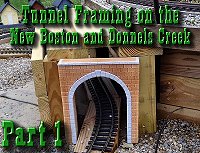 Tunnel Framing on the NEW New Boston and Donnels Creek, Part 1
Tunnel Framing on the NEW New Boston and Donnels Creek, Part 1 Tunnel Framing on the NEW New Boston and Donnels Creek, Part 2
Tunnel Framing on the NEW New Boston and Donnels Creek, Part 2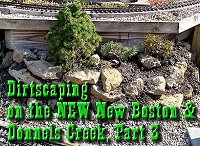 Dirtscaping on the NEW New Boston and Donnels Creek, Part 3
Dirtscaping on the NEW New Boston and Donnels Creek, Part 3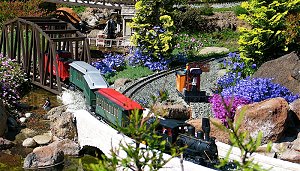 Garden Lines - Nancy Norris' Garden Railroad Design and Construction Services
Garden Lines - Nancy Norris' Garden Railroad Design and Construction Services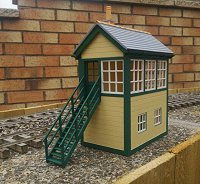 Kippo Models - UK-Inspired Resin Kits
Kippo Models - UK-Inspired Resin Kits
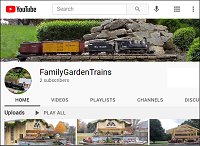 Family Garden Trains YouTube Channel
Family Garden Trains YouTube Channel
 Keep your eyes open. If you see yellow jackets or other paper wasps "hanging out" in any particular part of your garden, there may be more, maybe thousands more, within a foot or two of where you see them. Move buildings cautiously - they may have uninvited guests. I have "uninvited" more than one family by tossing the building in the pond and leaving it there for a while, but my buildings are built to withstand harsh weather, so that might not work out so well for yours.
Keep your eyes open. If you see yellow jackets or other paper wasps "hanging out" in any particular part of your garden, there may be more, maybe thousands more, within a foot or two of where you see them. Move buildings cautiously - they may have uninvited guests. I have "uninvited" more than one family by tossing the building in the pond and leaving it there for a while, but my buildings are built to withstand harsh weather, so that might not work out so well for yours.